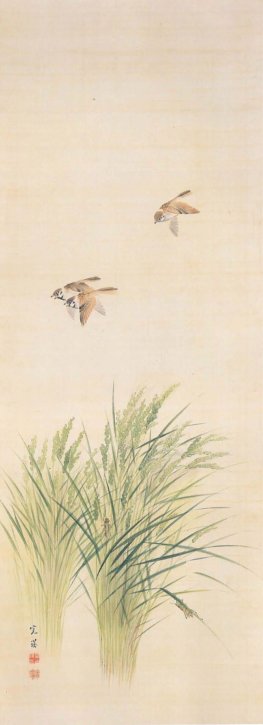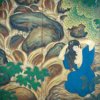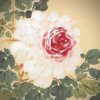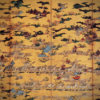Nishiyama Hōen / Nishiyama Kan-ei: Shijō School Painters Who Was Active in Osaka from the Late Edo Period to the Meiji Period
Nishiyama Hōen was a painter who brought the Shijō school to Osaka. He first learned from the Rinpa school painter Nakamura Hōchū in Osaka. Hōen took one letter from Hōchū and named himself Hōen. After his death, due to Hōchū’s will, he went to Kyōto and learned Shijō school painting from Matsumura Keibun. After that, he returned to Osaka and made great efforts to develop the Shijō school in Osaka.
In the latter half of the Edo period, there were some active painters in Osaka who worked on sketching, such as Ueda Kōchō, Nagayama Kōin, Ueda Kōfu, Mori Sosen, and Mori Tetsuzan. Of course, Nishiyama Hōen was one of those active painters. Ueda Kōchō and Nagayama Kōin were disciples of Matsumura Goshun, Hōen studied under Matsumura Keibun, Ueda Kōfu and Mori Tetsuzan studied under Maruyama Ōkyo. The Shijō school and Maruyama school both worked hard and improved together. The Maruyama-Shijō school began to develop quickly in Osaka, which is near Kyōto, and the schools were passed on to the next generation.
Nishiyama Kan-ei (1834-1897) was a child of the Shijō school painter, Nishiyama Hōen, and Kan-ei learned the painting from his father Hōen. It is no exaggeration to say that most of the leading painters at the end of the Edo period were Maruyama-Shijō school painters or the Nan-ga painters. By that time, the Maruyama-Shijō school had expanded its power. This may be because the styles of the two schools were familiar and easy to understand. It is said that Kan-ei served for the Akashi clan when he was in his late twenties, and he became active after the beginning of Meiji period in Osaka. It was mostly the people from the towns of Osaka that loved his works. Most of the Kan-ei’s paintings were used to decorate people’s houses since it was a simple painting with no strong personality, and people watched his painting to relax their eyes.
“Inaho Suzume-zu (Ears of Rice Plant and Sparrows)” by Nishiyama Kan-ei

Nishiyama Kan-ei’s paintings don’t not have strong personalities. In this painting as well, you can tell that this is a gentle and simple painting with just locusts stopping on the fruited rice ears, and three sparrows flying over it. However, you can feel the comfortable refreshing breeze of early autumn and the smell of rice ears from his work. Kan-ei was good at all of Sansui-ga (painting of the landscape), Jinbutsu-ga (painting of people), and Kachō-ga (painting of flowers and birds), but among them, he was good at Kachō-ga. In this painting, you can feel the personality of Kan-ei, which is a new sensation coming from a modern painter who lived from the end of Edo period to Meiji period, although there is a traditional Shijō school style, which is an accurate depiction based on sketches, in the painting.









